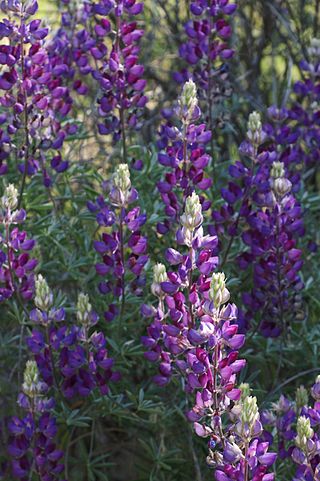
Lupinus nanus, the sky lupine, field lupine, dwarf lupin, ocean-blue lupine or Douglas' annual lupine, is a species of lupine native to the western United States. It is found natively in California, Nevada, and on Steens Mountain in eastern Oregon. It tends to grow on slopes and in open or disturbed areas below 1300 meters.

Gentiana andrewsii, the bottle gentian, closed gentian, or closed bottle gentian, is an herbaceous species of flowering plant in the gentian family Gentianaceae. Gentiana andrewsii is native to northeastern North America, from the Dakotas to the East Coast and through eastern Canada.

Astragalus canadensis is a common and widespread member of the milkvetch genus in the legume family, known commonly as Canadian milkvetch. The plant is found throughout Canada and the United States in many habitats including wetlands, woodlands, and prairies.

Lupinus bicolor is a species of lupine known as the miniature lupine, Lindley's annual lupine, pigmy-leaved lupine, or bicolor lupine.

Pedicularis groenlandica is a showy flowering plant in the family Orobanchaceae which is known as elephant's head, little pink elephant, elephantella, and similar common names inspired by the "striking" resemblance of the flower to the head of an elephant. Less commonly it is also called butterfly tongue for the long beak on the flower. Like many other plants in genus Pedicularis it is a parasitic plant and is dependent on host plants to survive.

Lupinus albifrons, silver lupine, white-leaf bush lupine, or evergreen lupine, is a species of lupine (lupin). It is native to California and Oregon, where it grows along the coast and in dry and open meadows, prairies and forest clearings. It is a member of several plant communities, including coastal sage scrub, chaparral, northern coastal scrub, foothill woodland, and yellow pine forest.

Mertensia ciliata is a species of flowering plant in the borage family known by the common names tall fringed bluebells, mountain bluebells, and streamside bluebells.

Lupinus affinis is a species of lupine known by the common name fleshy lupine. It is native to the California Coast Ranges from the San Francisco Bay Area north, and into southern Oregon, where it is an uncommon member of the flora in several areas.
Lupinus andersonii is a species of lupine known by the common name Anderson's lupine.

Lupinus brevicaulis is a species of lupine known by the common names shortstem lupine and sand lupine. It is native to the southwestern United States, including Oregon, California, Nevada, Utah, Colorado, Arizona, and New Mexico, where it grows in many types of sandy habitat.
Lupinus elmeri is an uncommon species of lupine known by the common names Elmer's lupine and South Fork Mountain lupine. It is endemic to California, where it is known only from a few scattered occurrences in the northernmost slopes of the North Coast Ranges, in Trinity county.
Lupinus hyacinthinus is a species of lupine known by the common name San Jacinto lupine. It is native to the mountains of southern California and adjacent Baja California, where it grows in dry areas, often in pine forests.
Lupinus saxosus is a species of lupine known by the common name rock lupine. It is certainly native to eastern Washington, eastern Oregon, and the northeast corner of California,where it grows in sagebrush and other habitat. It may also be native to Idaho and Nevada.

Bluebonnet is a name given to any of a number of purple-flowered or blue-flowered species of the genus Lupinus predominantly found in southwestern United States and is collectively the state flower of Texas. The shape of the petals on the flower resembles the bonnet worn by pioneer women to shield them from the sun. Species often called bluebonnets include:

Franklin's bumblebee is one of the most narrowly distributed bumblebee species, making it a critically endangered bee of the western United States. It is known only from a 190-by-70-mile area in southern Oregon and northern California, between the Coast and Sierra-Cascade mountain ranges. It was last seen in 2006. Franklin's bumblebee is known to collect nectar and pollen from several wildflowers, such as lupine, California poppy, and horsemint, which causes it to be classified as a generalist forager.
Wayfarers State Park is a 67-acre (27 ha) public recreation area overlooking Flathead Lake, one-half mile south of Bigfork, Montana. The state park hosts the annual Northern Rockies Paddlefest, which in 2013 attracted over 200 participants.

Triosteum perfoliatum, commonly known as perfoliate tinker's-weed, late horse gentian, common horse gentian, perfoliate-leaved horse-gentian, feverwort, and wild coffee, is a species of flowering plant belonging to the family Caprifoliaceae (honeysuckle). It is found in eastern and central North America. The yellow-orange berries can be dried, roasted, ground, and used as a coffee substitute.

Tradescantia subaspera, the zigzag spiderwort, is a species of flowering plant in the family Commelinaceae, native to the eastern United States. Its zigzagging stems and wider leaves distinguish it from Tradescantia virginiana. It is recommended for shady naturalistic garden settings. It has three petals which are violet-blue to purple in color. Flowers bloom May to September.

Thelesperma subnudum, commonly known as Navajo tea, is a perennial species of flowering plant in the family Asteraceae. It is found from west central Canada to central United States. It grows in openings in pinyon/juniper or yellow pine forests.














